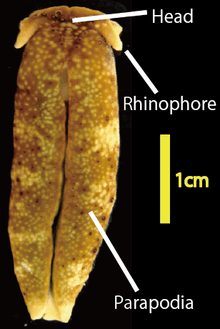Parapodium
The term parapodium (Gr. para, beyond or beside + podia, feet) refers to two different organs. In annelids, parapodia are paired, un-jointed lateral outgrowths that bear the chaetae. In several groups of sea snails and sea slugs, 'parapodium' refers to lateral fleshy protrusions.
Polychaete parapodia
.jpg)
Parapodia in polychaetes are either uniramous or biramous. In the latter case, the dorsal lobes or branches are called notopodia and the ventral branches neuropodia.
Both neuropodia and notopodia can bear cirri (called respectively neurocirri and notocirri) and setae (called respectively neurosetae and notosetae). The cirri between the two branches are called interramal cirri.
Gastropod parapodia

The fleshy protrusions on the sides of some marine gastropods are also called parapodia. They are particularly well-developed in sea butterflies. Some sea hares use their parapodia to swim. Parapodia can even be used for respiration (similar to gills) or for locomotion.
Parapodia are found in the following taxonomic groups of gastropods:
- Clade Cephalaspidea
- Clade Thecosomata
- Clade Gymnosomata
- Clade Aplysiomorpha